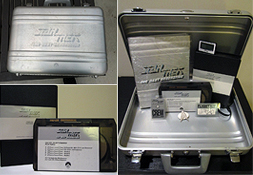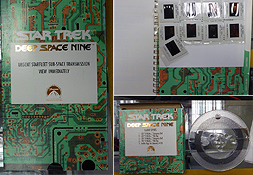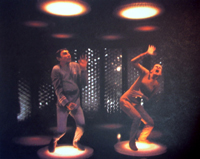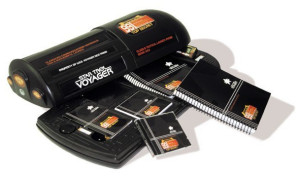 Star Trek fans tend to be memorabilia collectors, and it’s likely that most of us have that one piece of Trek merchandise that falls somewhere between “uncommon” and “rare” – but it’s not every day you find out that someone has a full-sized photon torpedo sitting in their house.
Star Trek fans tend to be memorabilia collectors, and it’s likely that most of us have that one piece of Trek merchandise that falls somewhere between “uncommon” and “rare” – but it’s not every day you find out that someone has a full-sized photon torpedo sitting in their house.
That’s just what North Carolina resident Marc Derro has in his possession. We came across a low-resolution photograph of this split-open torpedo model, filled with what looked like books and CDs, adorned with the Star Trek: Voyager logo – and our search began!
We stumbled upon a grainy video of a partial kit owned by a collector in Kentucky (which has since disappeared from YouTube), and that finally led me to Marc, who was more than happy to share his kit – and his story with us.
Marc Derro: “In 1999, I had just started working in TV in a very small market. I quickly made friends with the promotion manager and convinced her to let me have the kit after we had finished with it. Launch kits like these basically provide the local stations all of the materials necessary for help in promoting the launch of a show.
This is hands down the most awesome launch kit I have ever seen. The Trek theming of the entire kit is complete throughout, down to the little stickers by the light-activated computer voice. I am not sure who at Paramount was responsible for creating this kit, but it was certainly made with a lot of love.”
After viewing that detailed tour of the photon torpedo, we were compelled to dig deeper… after all, this is TrekCore: we don’t just say “good enough!”
We eventually made contact with long-time advertising producer Susan J. Sullivan, who served as the project lead for the Voyager torpedo project – we spoke on the phone in early August about this unique piece of Star Trek history.
![]()
TrekCore: What was your role with the kit? How did you get involved with this project?
Susan J. Sullivan: I was working as Director of Design for a company called Friedland Jacobs Communications. It was a broadcast advertising agency based out of Burbank, and my role was to oversee and facilitate the print and promotional materials that we did for our entertainment clients – one of which was Paramount’s television division.
At that time in the 1990s, most network television shows would be offered into syndication after they reached a certain number of episodes; Friedland Jacobs did the advertising for most of the marketing departments for these entertainment companies who were selling their shows into syndication.
The torpedo served as an affiliate promo kit – a device that houses the materials that each local station would use to promote the show as it entered into syndication in their area. There would be episode scripts, commercials, photography, print ads – all things they would use to customize the promotion for their own region.
TrekCore: The whole package is really rather impressive. Did you have any contact with the show’s art department or production team during the design process?
Sullivan: No, no, we didn’t – we dealt exclusively with the marketing department for Paramount Television. They keep those things pretty much separate; the show doesn’t really get involved with marketing. Our client was the director of the marketing department at Paramount, and it was that person who we had to please; they were the one who eventually approved it.
We would go in, present our mockups and designs, then go away – they would call us back after a few days and say, “Well, we like this part, but we don’t like that part,” you know, that sort of thing. I don’t know if they collaborated with the producers of the show at all, but I doubt it. I think it’s exclusively the marketing department who makes all of those decisions.
The lead designer on the project was a very talented young man named Michael Vamosy – Michael later worked as a vice president of marketing design for FX Network; he put together several prominent campaigns for FOX; now he works for the Starz network – but even though he was very new to the business when he worked with me at Friedland Jacobs, you could see how special and talented he was.
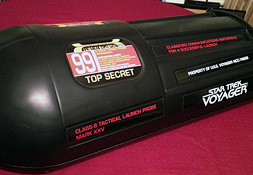 |
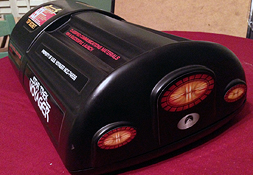 |
 |
|
| The torpedo media kit is not a small package – it measures more than thirty inches long. | |
We went out and bought books about Star Trek design – there are a lot of those available – and while I wrangled all of my most favored suppliers together, he would look through the books and watch a lot of the Voyager episodes to figure out what kind of show-specific icons might work best as an affiliate promo kit, eventually settling on the photon torpedo.
Michael was the art director on the project, so to speak; I worked in collaboration with him, contributing ideas along the way. Once he decided that the torpedo was the way to go, it became up to me to get all the vendors together and decide how it was going to be built – which materials to use; how it was going to be physically manufactured – and it was a hugely expensive operation because we didn’t plan on making that many kits.
TrekCore: How many torpedoes were put together?
Sullivan: I’m trying think about how many markets there would have been nationwide. Somewhere between 200 and 250, probably, but certainly not any more than that.
TrekCore: Voyager was still airing new episodes on UPN – it had just finished its fifth season when this was sent out – was this the first round of syndication marketing?
Sullivan: Voyager was actually going into its second year of syndication at that point. For the first season of syndication, the marketing team had put together a kind of aluminum clipboard thing; you could carry it around as if you were one of the Voyager crew.
Because we were going into the millennial year that season – remember, it was the fall of 1999 – the studio wanted to put out something pretty spectacular to build on the millennium hype. We had this clock that was programmed to count down to the September launch date; you would see this countdown when you opened the torpedo up, and an alarm would go off once it got to the premiere date.
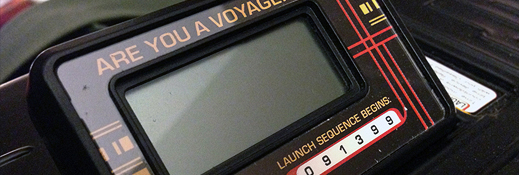 |
| Once the LCD clock reached the designated September 13 launch date, it could be reprogrammed for use as a regular digital clock – if you are “a Voyager.” |
TrekCore: Did any of the stations that received the kits ever give you any feedback?
Sullivan: No, not at all – they wouldn’t have even known that we worked on it at Friedland Jacobs. They might have contacted Paramount marketing to let them know, but we blind-shipped them without our information. Paramount was the client.
TrekCore: Walk us through manufacturing process – how did it go from development to production?
Sullivan: There were actually several separate steps involved, starting with the plastic shell.
A wooden die had to be created first, then refined and etched – this was the form that the plastic would adhere to while it was being shaped. There were artisans who worked to carve and sculpt the wooden die, and they were inclined to make it fairly simplistic and give it a smoother shape. We had to reject their initial designs because we really wanted a high level detail on the torpedo – all those intricate little pipes and vents and stuff – both on the inside and outside of the shell.
Once the shell was finished, we had to work out the labels and stickers that went onto it. This was done through another vendor, and we actually had to have them redone after the initial printing, because they didn’t use the right adhesive – they wouldn’t stick to the plastic!
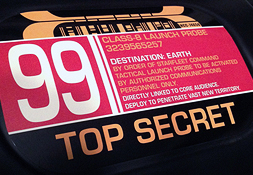 |
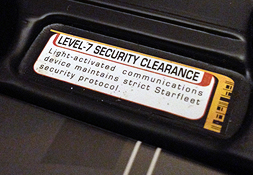 |
| Even though the torpedo package and label design were all created without input from the Trek art department, Vamosy replicated the look of the on-screen props quite accurately. | |
Michael chose to use a very simple design, sticking with solid colors and bold text, which really went against the trend of the era. Photoshop was still kind of new back then, and most advertisements were using glows and explosive rays of light and blended colors – all the stuff that showed that they were using all the Photoshop filters they could.
The choice to keep it really simple with the solid lines and colors was very innovative. I like to think that it signaled the trend that followed – the Photoshop filters and effects aren’t really used heavily anymore; things are back to the much more simple colors and lines from decades past.
TrekCore: I think that was a very good choice – the labels look much more like the props seen on the show, with the clear, bold labels listing instructions for the user.
Sullivan: It gives it kind of a military feel, don’t you think?
TrekCore: Absolutely – especially with those big TOP SECRET warnings!
Sullivan: The print work was another big part of the kit. Michael looked at lot of different binding options – deciding what would fit inside the kit, but still look sleek and modern – so he decided to have the books spiral-bound with plastic-coated spirals. He designed every piece in there, all the covers the books and CDs and so forth.
My role was to make sure that the printers got everything accurate, to be on-location at the print house, making sure that things looked right as they came off of the press. I’d stay for many, many hours until things looked correct, adjusting the colors and looking for imperfections until it was all correct.
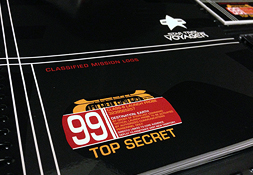 |
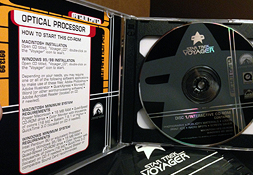 |
| Every part of the media kit – from VHS tape labels to book covers to the instructional inserts with the CD-ROMs – is designed along the same LCARS-esque theme. | |
TrekCore: What really surprised me was the use of electronics in the kit – it’s not just the clock, the torpedo actually talks to you!
Sullivan: Paramount wanted as many bells and whistles and gizmos as possible in there to make it a really spectacular presentation. We built in this light-activated voice chip, so that when you lifted off the lid, it would speak to you – just like the computer voice on the television show!
In addition to my regular job, I’m also an actress – I don’t act much anymore these days; I’m listed on IMDB as “Susan O’Sullivan” because I there was already another Susan Sullivan registered with the Screen Actors Guild when I started, so I had to change my registered name.
One of the earliest productions I was in after I moved to town from Toronto was actually Star Trek: The Motion Picture! I played Vice Admiral Lori Ciana – listed as “Woman” in the end credits – and that was me, screaming and writhing in pain as I got disintegrated by the transporter. I actually ended up as “Miss March” in one of the Star Trek calendars!
Anyway, we had auditioned a number of women who were very seasoned voice-over actresses – but because I had this sort of personal connection to Star Trek, I convinced the casting people to let me audition too! I put a recording of my voice into the mix, using my middle name on the submission – the client would have obviously recognized me – and they picked me!
So I got to be the computer when you lift off the lid – “STARFLEET CODED MESSAGE. COMMUNICATIONS OFFICERS ONLY.” – it’s my voice, which is just great!
TrekCore: I was digging through the advertising materials, and I thought the radio spots were really interesting. I know that at least in my area, I really don’t hear that kind of stuff much anymore.
Sullivan: That’s because syndication doesn’t really work like this anymore. It was kind of a dying time for our industry because these days, television shows launch and can go into syndication practically right away. The whole structure of how television stations buy shows has changed dramatically, and that’s one of the reasons that Friedland Jacobs eventually closed down – it had built its business entirely on selling shows into syndication, and that business isn’t there any longer.
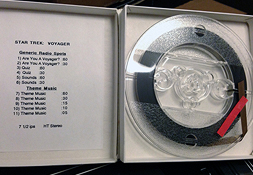 |
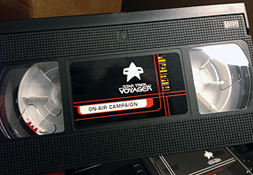 |
| While today’s multimedia is easily accessible online, audio and video material needed to be distributed via analog means in 1999 – by way of audio tape and VHS recordings. | |
Radio advertising is huge, is and always will be, since there are so many drivers on the road – “drive time” is what radio is all about. If you know you can air an ad during a well-listened-to program in the peak hours of the morning, you’re going to have thousands and thousands of ears on it. That’s just as good – and very often better – than spending money on a television commercial.
We’d create the recordings – not only full commercials, but audio clips from the show for customization – to certain technical specifications, so the local stations play it and then have somebody else locally add a tag like “Watch Star Trek: Voyager, tonight at 8 on CBS!”
TrekCore: How were media kits like this used on the local level?
Sullivan: We would supply what we called a “toolbox” to all of the stations – that toolbox contained all of these elements, that they could then go to their local radio station or newspaper, and customize with their specific information for their listings.
The studio then would give the kit for the local station managers – as a gift, basically – for spending the money to buy, say, twenty-six episodes, or something like a two-season contract. There’s a financial contract put in place there for how much each station is going to pay for the rights to air the episodes; part of the purchase price includes the gift of all the promotional materials.
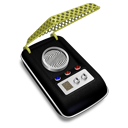 |
Voyager “Five Flights a Week” Radio Spots |
The studio wants to offer these incentives to the stations based on the prestige of the show. For Voyager, they really wanted something very flashy to send to the affiliates – “Here’s your gift! Isn’t it cool? It’s got everything you need!” They can take the pre-designed TV Guide ad, fill in their specific airing information, and send it off right to the newspaper; they don’t have to spend any more money developing their own advertising. It’s all part of the package.
It was really a standard thing, and we did other designs for different shows – we did kits for America’s Most Wanted, a big metallic cop notebook for NYPD Blue – but after the package arrives, the station manager usually takes the materials out, puts them on a shelf, and then either gets rid of the container or sticks it in a closet or something.
TrekCore: I really can’t imagine that there are many complete kits still out there.
Sullivan: Probably not – the advertising materials don’t usually stay inside, because it’s really impractical to store the stuff in the big package all the time. The notebooks and scripts and radio spots and videos all tend to end up on a shelf for regular use.
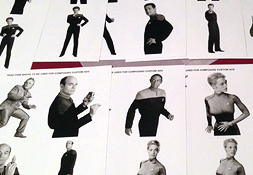 |
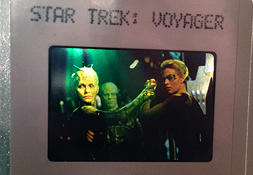 |
| Stock photography an important part of any marketing campaign – by including source photos and color slides, affiliates had everything needed to create eye-catching print ads. | |
If somebody likes it – they’ll take it home and give it to their kid, or maybe keep it as a collector… or they’ll give it to their assistant and say “Here, there’s no room for this in my office!”
Aside from the one you’re featuring, I know of two others that are intact – I helped design the thing, so I said, “We’re going to make some extra ones!” – one for me, and one for the agency. When Friedland Jacobs was closing, I wanted to take the agency’s torpedo home with me too, but one of the executives over there said, “Oh no – I’m taking that one!”
Thanks to Jeremiah Grant McClellan for arranging this interview.
Some portions have been condensed or edited for clarity.
![]()
Included with the print marketing material, these two Rolodex cards were intended for station mangers to keep for when they needed to contact Paramount – or when their local viewers would request information on how to send mail to the Voyager cast and crew.
 |
In addition to the advertising materials, Paramount also included dozens of pages of print information to help affiliates market the show in the most effective ways possible. These scans include demographic research on likely Voyager viewers and likely television viewing habits – because there’s “never a dull moment with a Voyager lifestyle”.
Other pages include suggested ideas for viewer contests, sometimes in collaboration with local news and radio teams – does anybody really want a free psychic reading? – as well as the famed “theme week” programming seen throughout Voyager‘s time in syndication.
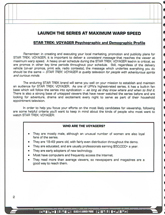 |
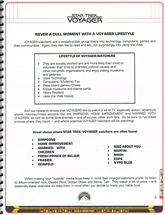 |
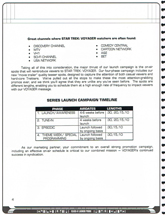 |
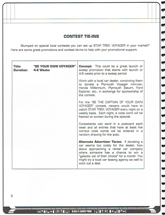 |
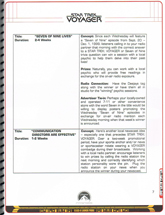 |
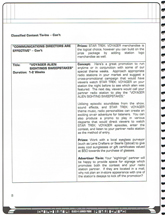 |
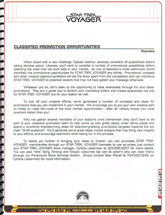 |
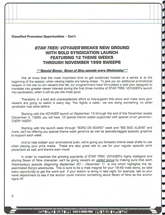 |
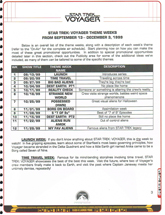 |
Lastly, the kit includes several high-quality pre-designed print advertisements in several different layouts and sizes, just waiting to be customized with each station’s scheduling information…
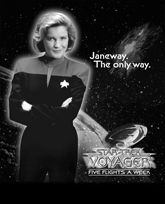 |
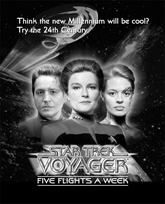 |
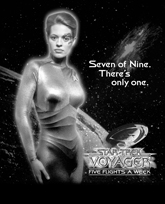 |
|||
 |
 |
||||
…but if the pre-made designs aren’t sufficient for an affiliate’s use, there are also dozens of separate visual elements available for the creation of perfectly customized advertisements.
This kit is the source of the Voyager syndication cast photos we have had in our archives for several years; the source images in the kit are layered Photoshop files for endless usage possibilities.
 |
|
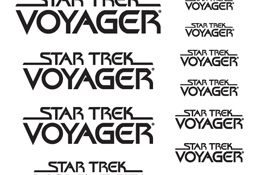 |
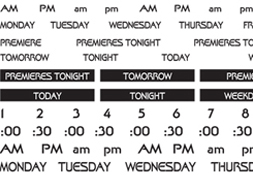 |
![]()
A lot of time went into the research and preparation for this feature – our sincere thanks go to Marc Derro for providing the detailed video and images from his torpedo kit for this project.

